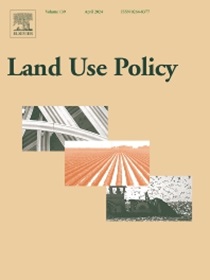Land use transitions and the decline of family farming in Southeastern Brazil: Patterns, pressures, and environmental trade-offs
IF 5.9
1区 社会学
Q1 ENVIRONMENTAL STUDIES
引用次数: 0
Abstract
The expansion of monocultures and urbanization has reshaped rural landscapes in Brazil. We evaluated how land use has changed in São Paulo state, since a decree defining family farming in the country was issued, and how it contributed to climate change and the ability to adapt to it. We analyzed land use changes between 1985 and 2023 across 601 municipalities, focusing on the dynamics of family farming and its environmental implications. Using data from Brazilian Agricultural Censuses and MapBiomas platform, we classified municipalities according to increases or decreases in the area under family farming, assessed their land tenure patterns, associated changes in land cover, and calculated carbon stock and sequestration values based on land use, to assess the relationship between them and the presence of family farming. Land tenure and land regularization processes affected family farming distribution, and agrarian reform processes have contributed to an increase in family farming areas and halted monocultures advance. Greater homogenization of local agriculture was observed, contributing to lower carbon sequestration where the reduction in family farming was more pronounced. Results show that municipalities with expanding family farming areas have higher forest cover, better pasture quality, greater carbon stock and sequestration values. Conversely, municipalities with declining family farming areas experienced higher growth in soybean monocultures and landscape simplification. These patterns underscore territorial and ecological impacts of agricultural concentration, and displacement of small-scale diversified systems. Our results show that policies targeting family farming can promote greater diversification, reduce landscape homogenization, and increase carbon sequestration capacity.巴西东南部土地利用转型和家庭农业的衰落:模式、压力和环境权衡
单一文化的扩张和城市化重塑了巴西的乡村景观。我们评估了圣保罗州土地利用的变化,以及它如何影响气候变化和适应气候变化的能力,因为该国颁布了一项规定家庭农业的法令。我们分析了1985年至2023年间601个城市的土地利用变化,重点关注家庭农业的动态及其对环境的影响。利用巴西农业普查和MapBiomas平台的数据,我们根据家庭农业面积的增加或减少对城市进行了分类,评估了它们的土地所有制模式、土地覆盖的相关变化,并基于土地利用计算了碳储量和固碳值,以评估它们与家庭农业存在之间的关系。土地所有制和土地正规化进程影响到家庭农业的分布,土地改革进程促进了家庭农业面积的增加,并阻止了单一栽培的发展。观察到地方农业同质化程度更高,在家庭农业减少更为明显的地方,这有助于降低碳固存。结果表明,家庭农业面积扩大的城市森林覆盖率更高,牧场质量更好,碳储量和固碳价值更高。相反,家庭农业面积减少的城市,大豆单一栽培和景观简化的增长更快。这些模式强调了农业集中对领土和生态的影响,以及小规模多样化系统的流离失所。研究结果表明,以家庭农业为目标的政策可以促进多样化,减少景观同质化,增加碳固存能力。
本文章由计算机程序翻译,如有差异,请以英文原文为准。
求助全文
约1分钟内获得全文
求助全文
来源期刊

Land Use Policy
ENVIRONMENTAL STUDIES-
CiteScore
13.70
自引率
8.50%
发文量
553
期刊介绍:
Land Use Policy is an international and interdisciplinary journal concerned with the social, economic, political, legal, physical and planning aspects of urban and rural land use.
Land Use Policy examines issues in geography, agriculture, forestry, irrigation, environmental conservation, housing, urban development and transport in both developed and developing countries through major refereed articles and shorter viewpoint pieces.
 求助内容:
求助内容: 应助结果提醒方式:
应助结果提醒方式:


